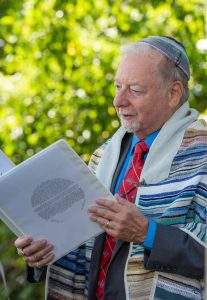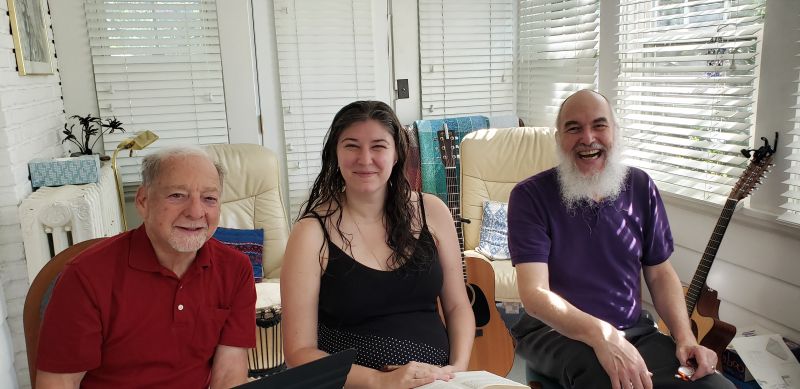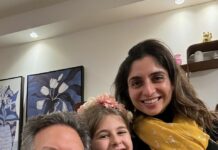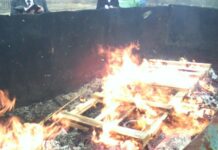Cantors, or chazzanim, are known to be among the most versatile of clergy members, wearing many different hats in addition to their kippahs.

Take, for example, a local jack of all trades, Cantor George Henschel of Kol HaLev Synagogue in Lutherville, whose curriculum vitae runs the gamut.
Born in the Bronx, N.Y., his family moved to Brooklyn and then to New Hampshire — a move made shortly before his 13th birthday and his bar mitzvah, and one that he described as “culture shock.”
He said that for the most part, his Jewish activities stopped until he was in his late 20s, married and with a daughter, and looking for a synagogue for the young family to attend. They wound up joining a small, progressive congregation that started a choir; he became a member, and the rest is, as they say, (musical) history.
The 73-year-old holds a B.A. in American history at Cornell University; a J.D. from Duke University School of Law; and cantorial certification from the American Seminary for Contemporary Judaism in Baldwin, N.Y. (The seminary is no longer active.)
After serving as a lay cantor in Northern Virginia for more than 15 years, he decided to turn the avocation into a vocation. He joined Kol HaLev, a Reconstructionist congregation, in 2007, the same year he earned his cantorial certification.
Before becoming a cantor, he was a synagogue president, taught classes in Hebrew liturgy and music, served as a cantorial soloist and choir member, participated in a Jewish folk group and is an expert shofar-blower. He does English and Hebrew calligraphy, having inscribed many certificates to commemorate baby-namings, b’nei mitzvot and weddings.
The cantor is also an avid hockey fan, as well as a dedicated cruciverbalist (crossword puzzle aficionado) who has finished as high as second place in the American Crossword Puzzle Tournament.
He and his wife, Ricki, moved to Baltimore in September 2008 and live in the Inner Harbor of Baltimore City. They are the parents of three grown daughters all residing in the Arlington/Falls Church area in Northern Virginia: Sarah (married to Jeff Goldhirsch), Rebecca and Tiffany. Sarah and Jeff have two children: Lucy, 13, who recently became a bat mitzvah; and Nat, age 10.
In an article he wrote for a 2014 compendium titled “Music, Carrier of Intention in 49 Jewish Prayers,” Henschel said poetically that “music stirs the soul. I can’t explain exactly how, but it does. There’s something about setting texts to melodies that transforms them. It’s as if the song takes the words and spins them around and around until the words and the music are one.”

What are some of the challenges of your profession, musically and otherwise?
I’m blessed to have a congregation that loves music and loves to sing. I’m working to find more ways to use music to connect with the younger groups of congregants. At Kol HaLev, we have begun an innovative program of intergenerational learning, and we are using music as one avenue of connection. Another challenge relates directly to the pandemic: While I like my voice, I’m not in love with hearing it in the vacuum of the Zoom world. The spiritual experience of voices singing together is something that I’ve always treasured, and I hope we get back to it full-time soon.
Describe some of the joys of being a cantor.
There’s nothing like singing the liturgy in a service that combines traditional nusach (the text of a prayer), classical settings and contemporary compositions. I’ve written quite a few liturgical pieces that my congregants love to hear and to sing. I didn’t write my first piece of music until I was in my 50s, and I really love being able to make the liturgy sing!
Recently, I made my first venture into writing choral music; my first choral work, “Song of the Heart,” will be sung at the Third Maryland Jewish Choral Festival at Ohr Kodesh Synagogue in Chevy Chase on Sunday, Feb. 5, conducted by my good friend, Hazzan Ramón Tasat. I sing in Ramón’s Jewish community chorus (named, interestingly enough, Kolot HaLev — “Voices of the Heart”).
I’ve also been blessed to serve with rabbis who appreciate what a cantor can bring to a congregation: Rabbi Geoff Basik for many years; and most recently, with our interim rabbi, Steven Silvern; and our rabbinical student, Emily Stern. Steven, Emily and I, along with congregant Shira Kurrus, sing together one Friday evening each month as Kol HaLev Unplugged.
How have you seen cantorial music change over the years? Are there many entering this field of service in synagogues, or are they trending towards recording and performing?
Cantorial music has indeed changed considerably since the early 20th century; the synagogue service has become much more participatory over time. There’s still room for cantors to sing music that calls on congregants just to listen, but my congregants like to sing with me or in call and response.
Modern congregations are not as familiar or knowledgeable about nus’chaot — the musical modes that are traditionally used for different parts of a service or different services (with the exception of the High Holy Days). For my own compositions, I try to adhere to the nusach that applies to the relevant section of the service, but I haven’t been rigid about it.
Speaking of performances, at the annual Interfaith New Year’s Eve Service in Baltimore on Dec. 31, you blew the shofar … for 41 seconds! What is the longest tekiah you have done? And how do you train for this?
I don’t know for sure what my record is, but some have told me it was around 47 seconds. I once played trumpet, so I assume that gave me a leg up in learning to sound the shofar. I learned by watching my former choir director in Virginia, Mitch Bassman, who is an absolute shofar master. But when I sound the shofar, I go into a zone where I’m not even aware of time going by. It’s only when the air starts to disappear that I come back to the world.
Name your favorite Jewish holiday and why.
I’m a big family person, and so I love to lead Passover seders with family and friends all around the table. I try to make every seder a little different while maintaining the songs and other elements that make it special. And I always focus on a cause or causes — ways that we can celebrate freedom by making the world a little better.
What is the best part of being a grandparent?
Grandchildren are such a gift; it’s so much fun to watch them grow and see how they develop their own ways of looking at the world. And it’s great to be able to spend time with them — to be part of their lives.







